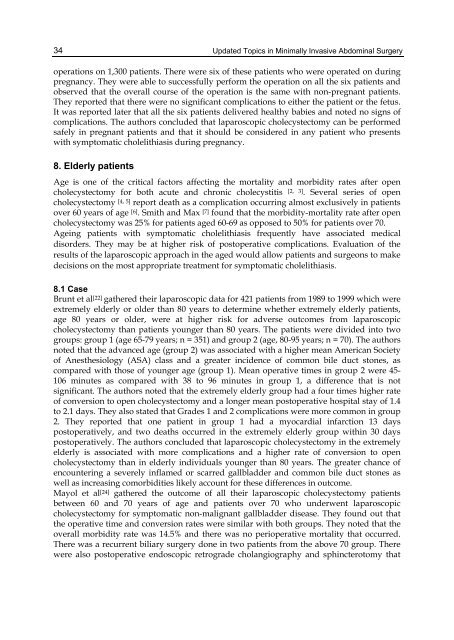UPDATED TOPICS IN MINIMALLY INVASIVE ABDOMINAL SURGERY
UPDATED TOPICS IN MINIMALLY INVASIVE ABDOMINAL SURGERY
UPDATED TOPICS IN MINIMALLY INVASIVE ABDOMINAL SURGERY
You also want an ePaper? Increase the reach of your titles
YUMPU automatically turns print PDFs into web optimized ePapers that Google loves.
34<br />
Updated Topics in Minimally Invasive Abdominal Surgery<br />
operations on 1,300 patients. There were six of these patients who were operated on during<br />
pregnancy. They were able to successfully perform the operation on all the six patients and<br />
observed that the overall course of the operation is the same with non-pregnant patients.<br />
They reported that there were no significant complications to either the patient or the fetus.<br />
It was reported later that all the six patients delivered healthy babies and noted no signs of<br />
complications. The authors concluded that laparoscopic cholecystectomy can be performed<br />
safely in pregnant patients and that it should be considered in any patient who presents<br />
with symptomatic cholelithiasis during pregnancy.<br />
8. Elderly patients<br />
Age is one of the critical factors affecting the mortality and morbidity rates after open<br />
cholecystectomy for both acute and chronic cholecystitis [2, 3]. Several series of open<br />
cholecystectomy [4, 5] report death as a complication occurring almost exclusively in patients<br />
over 60 years of age [6]. Smith and Max [7] found that the morbidity-mortality rate after open<br />
cholecystectomy was 25% for patients aged 60-69 as opposed to 50% for patients over 70.<br />
Ageing patients with symptomatic cholelithiasis frequently have associated medical<br />
disorders. They may be at higher risk of postoperative complications. Evaluation of the<br />
results of the laparoscopic approach in the aged would allow patients and surgeons to make<br />
decisions on the most appropriate treatment for symptomatic cholelithiasis.<br />
8.1 Case<br />
Brunt et al [22] gathered their laparoscopic data for 421 patients from 1989 to 1999 which were<br />
extremely elderly or older than 80 years to determine whether extremely elderly patients,<br />
age 80 years or older, were at higher risk for adverse outcomes from laparoscopic<br />
cholecystectomy than patients younger than 80 years. The patients were divided into two<br />
groups: group 1 (age 65-79 years; n = 351) and group 2 (age, 80-95 years; n = 70). The authors<br />
noted that the advanced age (group 2) was associated with a higher mean American Society<br />
of Anesthesiology (ASA) class and a greater incidence of common bile duct stones, as<br />
compared with those of younger age (group 1). Mean operative times in group 2 were 45-<br />
106 minutes as compared with 38 to 96 minutes in group 1, a difference that is not<br />
significant. The authors noted that the extremely elderly group had a four times higher rate<br />
of conversion to open cholecystectomy and a longer mean postoperative hospital stay of 1.4<br />
to 2.1 days. They also stated that Grades 1 and 2 complications were more common in group<br />
2. They reported that one patient in group 1 had a myocardial infarction 13 days<br />
postoperatively, and two deaths occurred in the extremely elderly group within 30 days<br />
postoperatively. The authors concluded that laparoscopic cholecystectomy in the extremely<br />
elderly is associated with more complications and a higher rate of conversion to open<br />
cholecystectomy than in elderly individuals younger than 80 years. The greater chance of<br />
encountering a severely inflamed or scarred gallbladder and common bile duct stones as<br />
well as increasing comorbidities likely account for these differences in outcome.<br />
Mayol et al [24] gathered the outcome of all their laparoscopic cholecystectomy patients<br />
between 60 and 70 years of age and patients over 70 who underwent laparoscopic<br />
cholecystectomy for symptomatic non-malignant gallbladder disease. They found out that<br />
the operative time and conversion rates were similar with both groups. They noted that the<br />
overall morbidity rate was 14.5% and there was no perioperative mortality that occurred.<br />
There was a recurrent biliary surgery done in two patients from the above 70 group. There<br />
were also postoperative endoscopic retrograde cholangiography and sphincterotomy that














![focuspdca.ppt [Compatibility Mode]](https://img.yumpu.com/22859457/1/190x146/focuspdcappt-compatibility-mode.jpg?quality=85)


